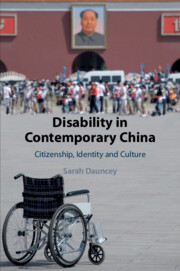Book contents
- Disability in Contemporary China
- Disability in Contemporary China
- Copyright page
- Dedication
- Contents
- Figures
- Acknowledgements
- A Note on Language
- Abbreviations
- Introduction
- 1 Where Did All the Disabled People Go?
- 2 Backstage to Centre Stage
- 3 Entertainment or Education?
- 4 A Narrative Prosthesis?
- 5 Blind, but Not in the Dark
- 6 Private Lives for Public Consumption
- Conclusion
- References
- Index
1 - Where Did All the Disabled People Go?
Cultural Invisibility Before 1976
Published online by Cambridge University Press: 18 September 2020
- Disability in Contemporary China
- Disability in Contemporary China
- Copyright page
- Dedication
- Contents
- Figures
- Acknowledgements
- A Note on Language
- Abbreviations
- Introduction
- 1 Where Did All the Disabled People Go?
- 2 Backstage to Centre Stage
- 3 Entertainment or Education?
- 4 A Narrative Prosthesis?
- 5 Blind, but Not in the Dark
- 6 Private Lives for Public Consumption
- Conclusion
- References
- Index
Summary
Chapter 1 unearths the hidden history of disabled people in China during the Mao era. This was a period when the traditional attitudes towards disability and impairment discussed in the Introduction would begin to take on new guises as the newly formed PRC established its foundations. The chapter shows how the rise of socialism, the equation of a ‘healthy’ body with a healthy nation, as well as the great economic endeavour of the time, combined to offer new ideas for personhood and new forms of para-citizenship. But this was to come at a cost. The increasing undesirability of impairment because of these revolutionary endeavours, which sought to mobilise as much of the population as possible, would limit the representation of disabled people across all forms of cultural production. Notable disabled exemplars from inside and outside China would, however, offer concrete ways to understand both state and personal views of the role disability could play in this new age. From fictional Pavel Korchagin’s ‘hybrid form’ to real-life Wu Yunduo’s heroism and the miraculous curing of deaf and blind children, disabled people were transformed from the ‘useless’ into the ‘useful’ of society.
Keywords
- Type
- Chapter
- Information
- Disability in Contemporary ChinaCitizenship, Identity and Culture, pp. 37 - 61Publisher: Cambridge University PressPrint publication year: 2020



